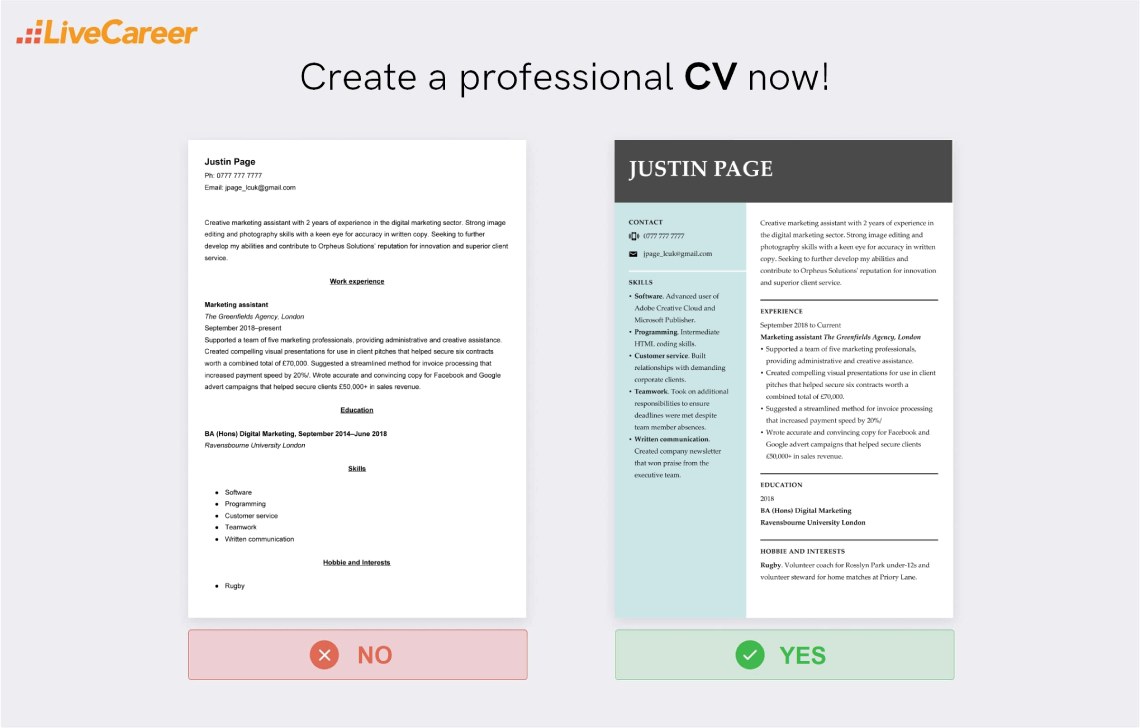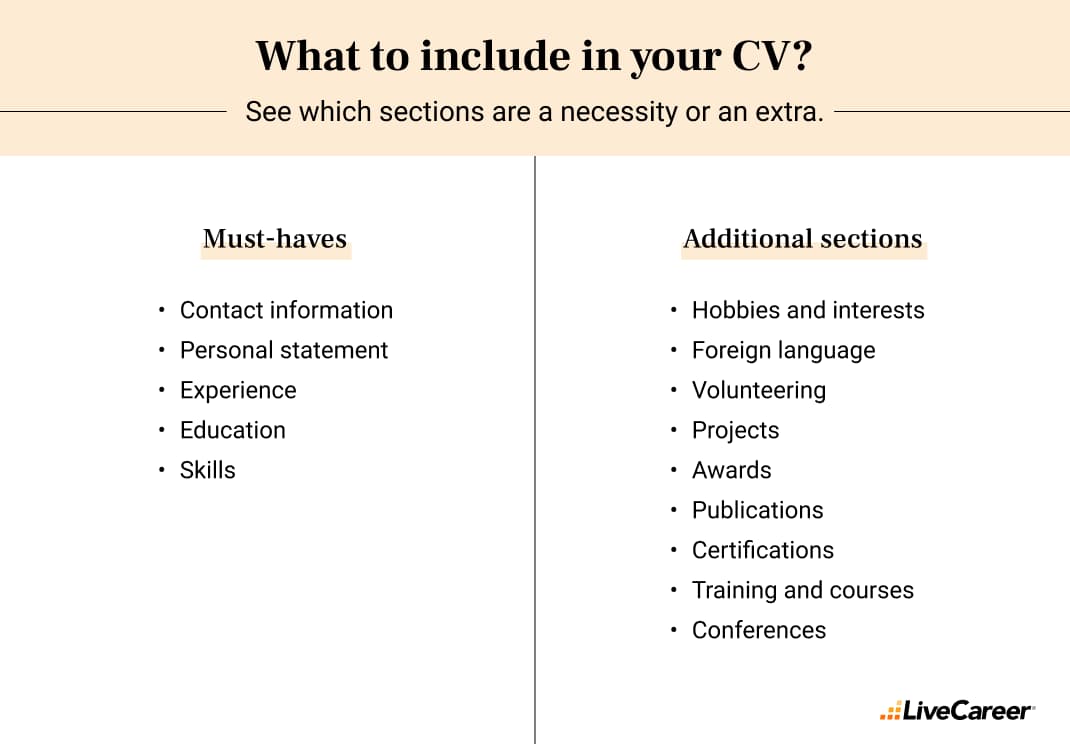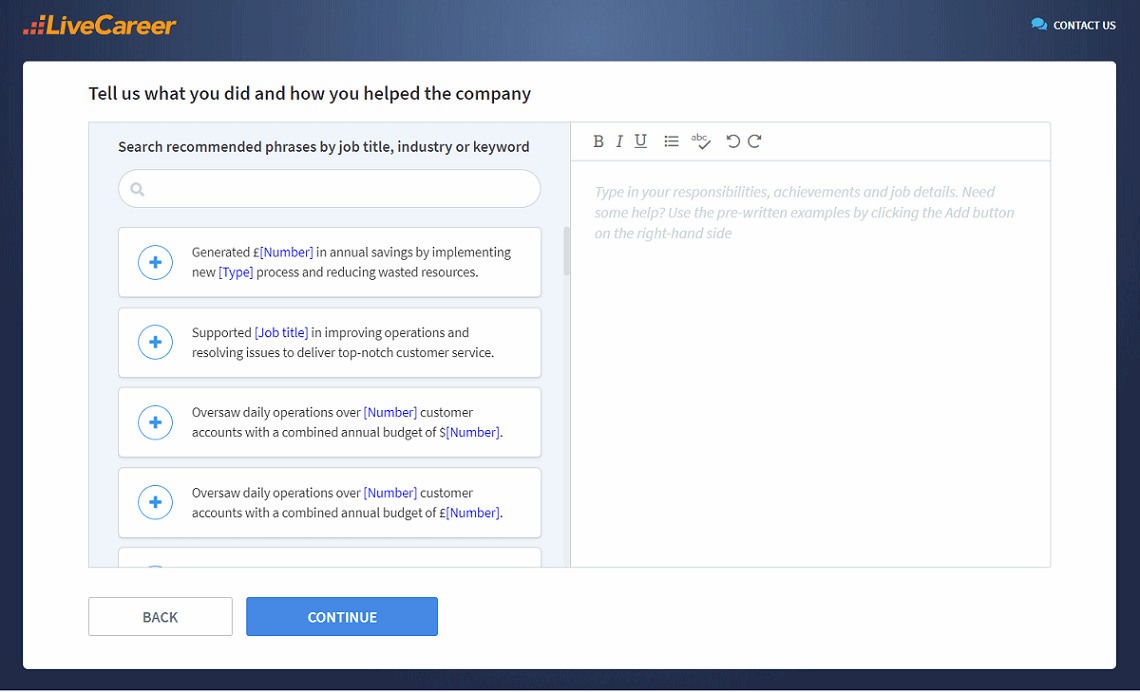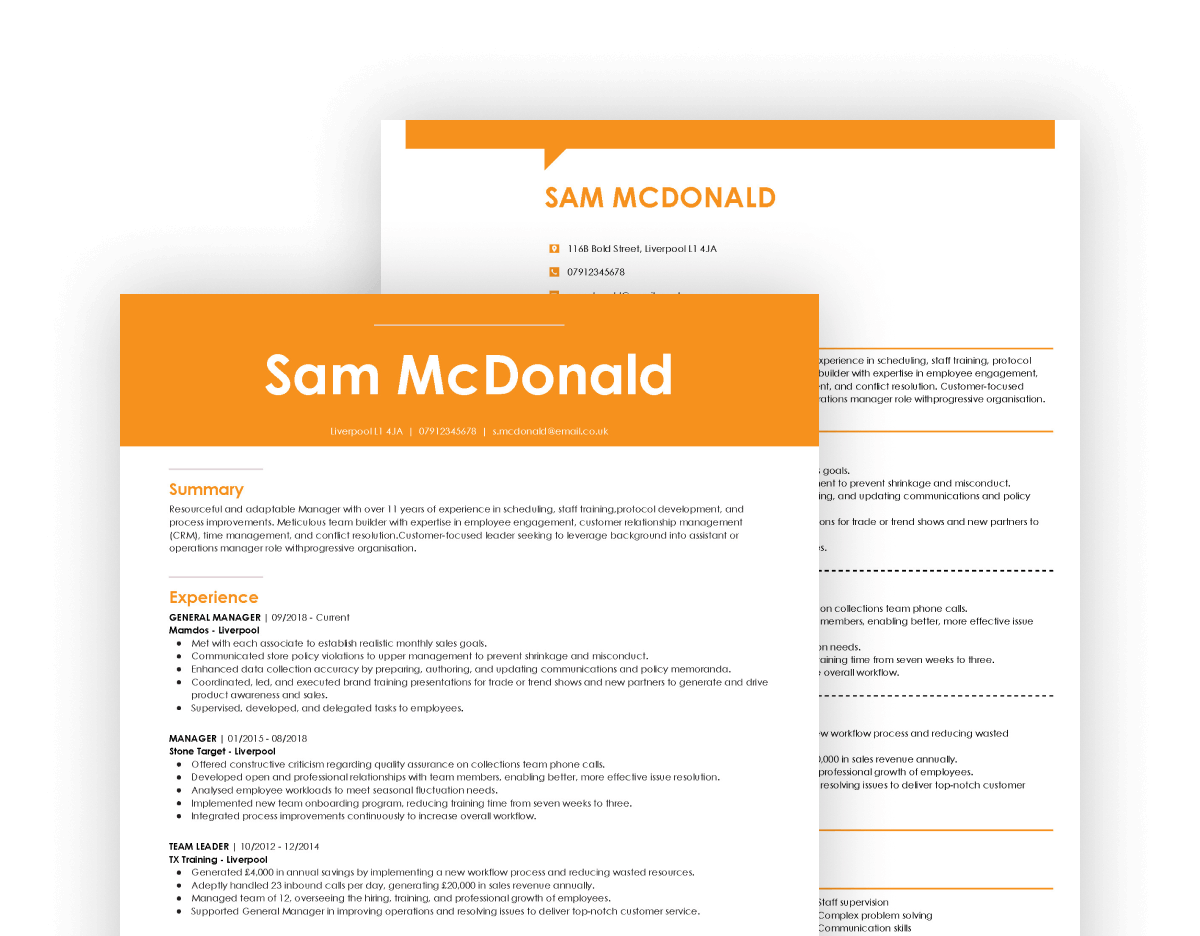
How to Write a Perfect CV in 7 Steps (UK Examples)
Want to know how to write a perfect CV for a job in the UK? Check our perfect CV example, templates, and learn to format a perfect CV all by yourself.
Our customers were hired by:
Wherever you are in your career, writing a CV is an excellent opportunity to highlight your strengths. With the right strategy, it’s easy to stand out—once you know what to include in a CV.
This guide will show you exactly what to put on a CV to impress recruiters, from must-have details to how to structure all the key CV sections. You’ll also find a ready-to-use example to help you decide what to put in a CV and create one that truly shines.
Key Article Insights:
Create an effective CV in minutes. Choose a professional CV template and fill in every section of your CV in a flash using ready-made content and expert tips.

We created the sample on the right using our builder. See other good CV examples like this one.
Regardless of the job you are applying for, there are certain sections that every CV should have. Here are the 6 main things your CV should include:

Your contact information is the absolute key section in any CV. It should be valid and put in the CV header.
Here’s what personal details you should put in your CV’s contact info section:
And a gentle reminder: Don’t include your picture and a postal address; they just waste precious space, especially if you aim to write a one-page CV. Also, leave out personal information like date of birth, etc., as it leaves you open to discrimination.
What to put in a CV: contact information
Justin Page
Marketing Assistant
Ph: 0777 777 7777
Email: jpage_lcuk@email.com
LinkedIn: linkedin.com/in/justin-page
Website: www.justinpage.com
The personal statement on a CV is vital because it gives recruiters a quick, compelling overview of who you are, what you offer, and why you’re the right fit for the job. Writing a strong personal statement helps you immediately grab the employer’s attention and encourages them to read the rest of your CV.
The personal statement, also known as a CV summary or CV profile, is an introduction to you as a candidate. You have to structure it in such a way that you convince the hiring manager you meet the basic requirements of the job you’re applying for. And the best way to decide what to include in a CV personal statement is to answer these questions.
So, in the first sentence of your CV introduction, mention your job title and how much experience you have. Then mention skills or experience that match the job requirements. You can do this by referring to the job advert, noting the key requirements, and then choosing a professional accomplishment or skill of your own that matches. And finish off by stating how you plan to grow, develop and contribute to your new employer.
What to include on a CV: personal statement
Creative marketing assistant with 2 years of experience in the digital marketing sector. Strong image editing and photography skills with a keen eye for accuracy in written copy. Seeking to further develop my abilities and contribute to Orpheus Solutions’ reputation for innovation and superior client service.
A strong CV summary will convince the recruiter you’re the perfect candidate. Save time and choose a ready-made personal statement written by career experts and adjust it to your needs in the LiveCareer CV builder.

The work experience section on a CV is one of the most important parts to include because it shows exactly how you’ve applied your skills in real-world situations.Employers often focus on this section first to evaluate whether you have the right background and achievements to succeed in the role.
List your jobs in reverse chronological order, starting with your most recent role. For each job, include your title, the employer’s name, and your dates of employment. Describe your responsibilities and professional achievements using strong action verbs and accomplishment statements. Quantify your impact with numbers, where possible, to make your experience even more convincing.
Things to put on a CV: work experience section
Marketing Assistant
The Greenfields Agency, London
September 2018–Present
A CV education section is essential to put in your CV because it highlights your academic background, proves your qualifications, and helps employers quickly assess if you meet the role’s educational requirements.
If you’re a university graduate or still studying, include your degree name, university name, and dates of study. If you’re writing a school leaver CV, list your A-levels with subjects, school name, and dates. GCSEs are only necessary if you’re a recent school leaver—mention maths and English explicitly, as they are often minimum requirements.
You can also adjust your CV structure: if you’re writing a CV for your first job and have little experience, place your education section before your work history. It’s also useful to mention specific modules, projects, or extracurricular activities if they’re relevant to the job you are applying for.
What to include in a CV: education example
BA (Hons) Digital Marketing
Ravensbourne University London
September 2014–June 2018
The skills section on a CV is crucial because it shows at a glance that you have the abilities needed to succeed in the role. Knowing what skills to put on a CV can directly influence whether your application gets shortlisted.
Start by listing all of your professional skills. Next, highlight all the skills mentioned in the job advert and note any general transferable skills that would be applicable too. Then, choose 5–10 of your own skills that match the job requirements and include them on your CV.
You can also add a short sentence for each skill demonstrating your abilities. Try to find a good mix of soft skills and hard skills, and if in doubt, remember that some skills are universal. For example, IT skills and communication skills will look good on every CV.
What does a CV need: skills example
Adding additional sections to your CV is important because it helps you show extra qualifications, interests, and achievements that can set you apart from other candidates.
Including sections like hobbies and interests, volunteering, additional languages, certifications, and professional awards demonstrates that you are a well-rounded, motivated individual. If the information is relevant to the job and strengthens your profile, it’s definitely worth putting it in your CV.
What to put on a CV: hobbies and interests
Justin Page
Marketing Assistant
Ph: 0777 777 7777
Email: jpage_lcuk@email.com
LinkedIn: linkedin.com/in/justin-page
Website: www.justinpage.com
Personal statement
Creative marketing assistant with 2 years of experience in the digital marketing sector. Strong image editing and photography skills with a keen eye for accuracy in written copy. Seeking to further develop my abilities and contribute to Orpheus Solutions’ reputation for innovation and superior client service.
Work experience
Marketing Assistant
The Greenfields Agency, London
September 2018–present
Education
BA (Hons) Digital Marketing
Ravensbourne University London
September 2014–June 2018
Skills
Hobbies and Interests
A CV isn’t simply a list of sections. There’s more to it than that. Your CV should look good and be easy to read too, and the way to do that is with an effective CV layout. Follow these simple rules and you’ll have included all the elements you need for a perfect CV structure.
Here we have another example of where what not to include in a CV is just as important as what you do include. In this case it’s all about how you create white space on the page to frame your content, it improves readability and makes your basic CV template more visually appealing.
All you need to do is set your page margins to one inch on all four sides, set line spacing at 1.15 and double space between all sections of your CV. That way, you’ll create the perfect balance between content and white space.
Your choice of font is also a critical consideration when deciding what to include in a CV. And it’s not just for looks, your CV font type actually alters the way you retrieve information from the page. In other words, a good font makes it easier for the recruiter to find the information they need and discover why you’re the best candidate.
But you don’t need to do anything fancy. The good old reliable classics are your best choice. We’d recommend sticking with dependable choices like Times New Roman, Arial, Garamond and Helvetica.
It’s not just about what to include in a CV, it’s also about how much to include. The best CV length is 1–2 pages. Go for a one-page CV if you’re a fresh graduate or school leaver. It’s also a good choice for candidates with less than five years of experience.
Go for a two-page CV if you have more than five years of experience. And if you’ve got 10 or more years of experience and you’re targeting a senior position or you’re in a technically complex role then you could even stretch to a three-page CV.
Specialist formats such as an academic CV or a medical CV could be even longer, but for the majority of candidates 1–2 pages is the ideal CV length.
When you’re finished writing, it’s important to keep your layout looking perfect. The best way to do that is to save your CV in PDF format unless the job advert requests otherwise. That way, you can be sure that absolutely everything you’ve decided to include in your CV stays intact.
A CV that’s written to UK standards should not include the following sections:
Having examined 6 million CVs created in our builder, we found that*:
*The data comes from a period of 12 months (August 2023-August 2024).
You don’t have to be a CV writing expert. In the LiveCareer CV builder you’ll find ready-made content for every industry and position, which you can then add with a single click.

Do you need more help with your CV? We recommend the following guides:
Thanks for reading. If there’s anything else you want to know about what to include in a CV, please ask in the comments section, and we’ll be happy to help.
*Data was collected from July 2023 to June 2024.
Our editorial team has reviewed this article for compliance with LiveCareer’s editorial guidelines. It’s to ensure that our expert advice and recommendations are consistent across all our career guides and align with current CV and cover letter writing standards and trends. We’re trusted by over 10 million job seekers, supporting them on their way to finding their dream job. Each article is preceded by research and scrutiny to ensure our content responds to current market trends and demand.
About the author
Danuta Detyna is a Certified Professional Résumé Writer and career expert with over nine years of writing experience. Known for her empathetic, detail-oriented approach, she creates practical and empowering career resources that help job seekers move forward with confidence.
Rate this article:
What to include in a cv
Average:


Want to know how to write a perfect CV for a job in the UK? Check our perfect CV example, templates, and learn to format a perfect CV all by yourself.

Small changes can make a big difference. Get 30+ simple to implement CV writing tips for the UK that'll take your job application to the next level.

What is an ATS-friendly CV, and how to prepare one? This comprehensive guide covers everything you need to know about ATS-optimised CVs, templates, and more.
Our customers were hired by: